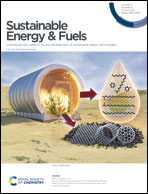P-doped CoCO3 nanosheets: an ultra-active versatile electrocatalyst for hydrogen evolution, oxygen evolution and hydrazine oxidation reactions†
Abstract
Developing cost-effective and highly efficient electrocatalysts is urgent for a sustainable hydrogen economy. In this work, a versatile electrocatalyst was developed by growing P-doped CoCO3 nanosheets on Co foam (P–CoCO3/CF). Benefiting from the well-designed nanostructure, good electrical conductivity and high intrinsic activity, the P–CoCO3/CF exhibits excellent multifunctional electrocatalytic performance towards the hydrogen evolution reaction (HER), the oxygen evolution reaction (OER), and the hydrazine oxidation reaction (HzOR), respectively. According to the results, only low cell voltages (at j = 10/100 mA cm−2) of 1.55/1.77 V are required for the P–CoCO3/CF(+)‖P–CoCO3/CF(−) two-electrode couples in 1 M KOH, which are both better than those of RuO2(+)‖Pt/C(−) couples. Surprisingly, for using the HzOR as a substitute for the OER, only a voltage (at j = 100 mA cm−2) of 0.13 V is needed, which is the smallest potential for hydrogen production reported so far. Theoretical calculations demonstrate that P doping tunes the electronic properties of catalytic center-Co, leading to the desired decrease of the free energy of the rate-determining-step (rds) and efficiency amelioration of HER and HzOR processes.



 Please wait while we load your content...
Please wait while we load your content...